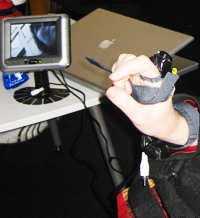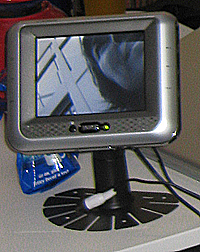Third Eye Prototype 1
This prototype consists of a cheap ultra mini CMOS camera which is attached to a finger using gaffer tape and velcro and has its composite video output connected to a small monitor. This was very quickly constructed as it only required a small amount of soldering and fabrication. However, it is very useful for exploring whether one would want a mobile or fixed Third Eye. Having the camera on a finger means that the video image shifts orientation, depending on the attitude of the hand - the top can rapidly become the bottom. Should we use some sort of sensor to detect this change in orientation and correct the image? Or could a user adapt?
The prototpye makes very clear the constrains that a movable camera place on the mapping can take place from the image to the vibrotactile array. What useful information is in an image that is independent of orientation? Looming, perhaps, but not object recognition.
One tester said that they would like the ability to zoom in and out with the ring - this would require more wiring and a more expensive and slightly larger camera.The current camera could be made into a chunky ring (it's smaller than some rings that peole wear) but making it a wireless device would be trickier. This raises the question of whether the Third Eye is meant to be clandestine or very obvious?


